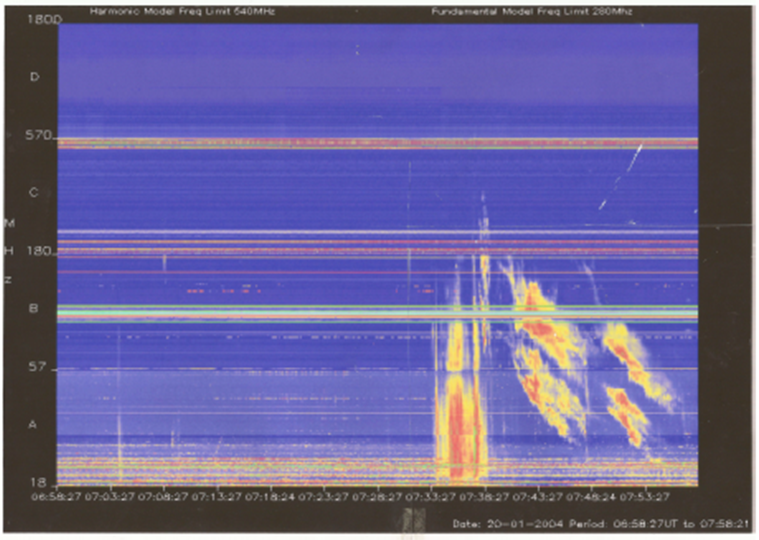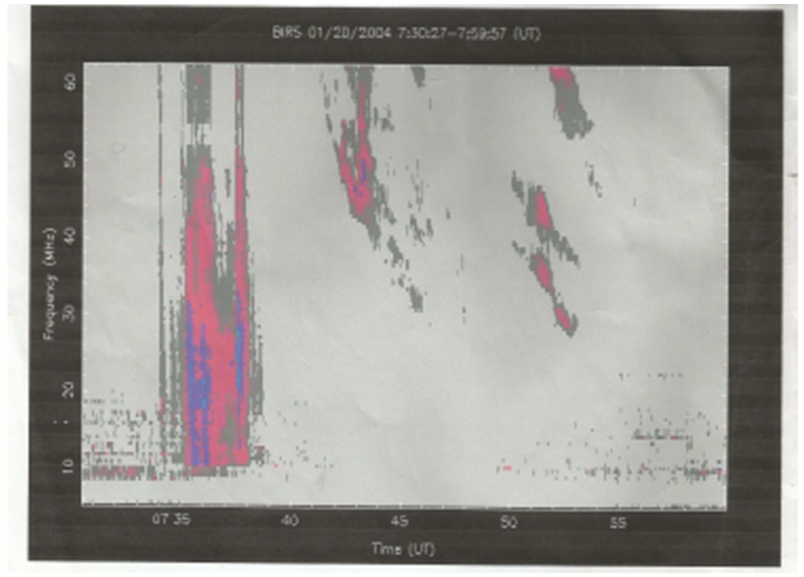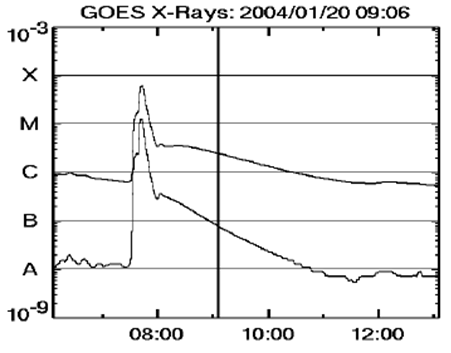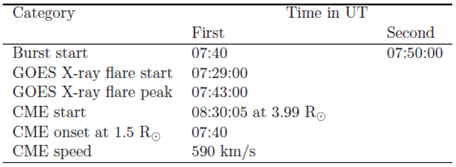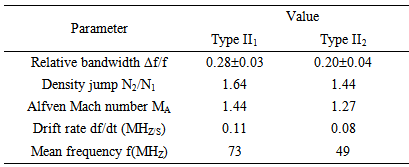-
Paper Information
- Paper Submission
-
Journal Information
- About This Journal
- Editorial Board
- Current Issue
- Archive
- Author Guidelines
- Contact Us
International Journal of Astronomy
p-ISSN: 2169-8848 e-ISSN: 2169-8856
2014; 3(1): 22-29
doi:10.5923/j.astronomy.20140301.03
Estimation of Coronal Magnetic Field Using Multiple Type II Radio Bursts
Vijaykumar H. Doddamani1, Raveesha K. H.2, K. R. Subramanian3
1Dept of Physics, Bangalore University, Bangalore, Karnataka, India
2Dept of Physics, CMR Institute of Technology, Bangalore, Karnataka, India
3Indian Institute of Astrophysics, Bangalore, Karnataka, India
Correspondence to: Raveesha K. H., Dept of Physics, CMR Institute of Technology, Bangalore, Karnataka, India.
| Email: |  |
Copyright © 2014 Scientific & Academic Publishing. All Rights Reserved.
The magnetic fields in the corona is determined using multiple type II radio bursts observed on 20 January 2004 with the Culgoora solar radio spectrograph. Using the relation between the relative bandwidth of the band-split and the density in the upstream and the downstream of the shock the Alfven Mach number is estimated. From the observed drift rates of the multiple type II bursts the Alfven speed and the magnetic field is estimated. The relative bandwidths for the first and second type II bursts respectively are 0.28 and 0.20. The Alfven Mach numbers for the first and second bursts respectively are 1.64 and 1.44. The mean frequency of the first type II burst is 73 MHz and the same for the second burst is 49 MHz. The derived magnetic field varies from 1.30 to 2.24 Gauss for the first burst and 1.32 to 2.46 Gauss for the second burst for Newkirk’s density with density enhancement factors 1 to 5. The associated activities show a single flare and a Coronal Mass Ejection (CME). The results are discussed in the frame work of the single flare/CME.
Keywords: Corona, Type II bursts, Shocks, Alfven velocity, Magnetic field
Cite this paper: Vijaykumar H. Doddamani, Raveesha K. H., K. R. Subramanian, Estimation of Coronal Magnetic Field Using Multiple Type II Radio Bursts, International Journal of Astronomy, Vol. 3 No. 1, 2014, pp. 22-29. doi: 10.5923/j.astronomy.20140301.03.
Article Outline
1. Introduction
- Magnetic fields play an important role in the solar atmosphere. In the absence of magnetic field, the Sun would show only minor deviations from spherical symmetry due to the differential rotation and meridian circulation. Without the magnetic field, phenomena and process on the sun like sunspots, coronal loops, faculae, solar flares, solar wind, and prominences would be unknown to us. Magnetic field is considered to be the main factor for coronal heating, particle acceleration and the formation of structures like prominences and Coronal Mass Ejections. They also play an important role in the accumulation and release of many forms of energy in the solar surface. Measurements of the strength of the solar magnetic field had been done in the past by several methods. At the photosphere levels, Zeeman splitting of the lines in the visible part II radio bursts had been used for the determination of the coronal magnetic field (Fomichev & Chertok, 1966; Smerd et al. 1974; Karlicky & Tlamicha, 1979; Gary et al. 1984; Vrsnak et al. 2001; Cho et al. 2007). Type II radio bursts were first discovered by Wild & McReady (1950) from the dynamic spectra of solar radio bursts. In the frequency - time plane, a type II radio burst shows a drift from high to low frequency with a drift rate of 0.5 MHz/s. The slow drift rate of a type II burst is interpreted as the radio signature of a collision less Magneto hydrodynamic (MHD) shock wave generated in the tenuous solar corona (Uchida, 1960). The radio emission process of a type II burst is due to the plasma oscillations from the electron accelerated at the moving shocks (Wild et al. 1963; Nelson & Melrose, 1985). These plasma oscillations occur at the local plasma frequency and the scattering of the plasma waves on the background ions results in electromagnetic waves at the fundamental and the coalescence of two plasma waves results in the second harmonic. In some cases the fundamental harmonic bands of type II bursts are split into two, called as band-splitting. Band-splitting occurs form both the upstream (Smith, 1971) and downstream (Tidman, 1965, Tidman et al. 1966) of the coronal shock front. Smerd et al (1974) related the spectral width of the band split to the shock compression ratio which then yields the Alfven Mach Number MA under the Rankine - Hugoniot jump relation. By relating the speed of the type II radio burst to Alfven Mach number, the Alfven speed of the shock wave generating type II radio burst can be calculated. Using the relation between the Alfven speed and the mean frequency of observations, the magnetic field strength can be derived at a particular height in the solar corona. Since the MHD shock waves of the type II radio bursts sweep through the entire corona on a global scale, the measurements using type II bursts are better, since they are not confined to the flaring active regions. Again metric type II bursts occur in the solar corona at heights from 1.1 to 2 solar radii. The magnetic field in the region of 1.1 - 3 solar radii is especially important as the interface between the photospheric magnetic field and the solar wind. Several observations are required to estimate the strength of the magnetic field at different heights since the mean frequencies of type II bursts are different for different type II bursts. Two type II bursts sometimes occur in sequence with a time delay of 10-15 minutes and were first reported by Robinson & Sheridan (1982) and then by Gergely et al. (1984). In a dynamic spectrum, these radio bursts appear as two type II bursts occurring one after another, with both the bursts showing fundamental /harmonic bands and with a gap in emission lasting for about 10 minutes. Both these two bursts show drift from high to low frequencies. Physical properties of the two components of multiple type II bursts and the relation between the two components were studied by Shanmugharaju et al. (2005) and Subramanian & Ebenezer (2006). From a detailed statistical study of multiple Type II bursts these authors have showed that the second type II radio burst always occurs a lower frequency compared to the first type II radio burst indicating that the second type II radio burst always occurs higher in the solar corona compared to the first type II radio burst. Therefore multiple type II bursts have the advantage of estimation of the strength of the magnetic field two different heights simultaneously if both the bursts show band-split. The occurrence of multiple type II burst with band-split in both the components of multiple type II bursts is very rare. Multiple type II bursts event of January 20, 2004 which showed band split in both the bursts were analyzed and the results are presented in this paper.
2. Method, Data and Analysis
- From the in-situ measurements of interplanetary shocks it had been proved by Gurnett et al., (1979) and Kennel et al., (1982) that high and low frequency plasma waves are enhanced in the shock region. Since both low and high frequency plasma waves are required for the generation of type II burst radiation, it was suggested by Mann et al (1995) and Vrsnak et al., and references therein (2001), that solar type II bursts are generated in the vicinity of shock front region of a coronal shock wave. According to Vrsnak et al. (2001), the density jump at the shock front is related to the instantaneous relative bandwidth of the band-split (∆f/f) of the type II radio burst. The method involves the assumption that in the front of the shock region (upstream), the electron density N1 is lower and corresponds to a plasma frequency of fl. The plane behind the shock (downstream) corresponds to the back region of the shock, where the electron density N2 is higher and hence higher plasma frequency of fu. The Rankine - Hugoniot relation (Priest, 1943; Tidman and Krall, 1971) gives the relation between the up and down stream quantities of the shock wave like particle density, velocity and the magnetic field. Since the plasma frequency fp and hence the radio frequency is related to the electron density Ne by the relation
 N is the electron density in cm-3The relative bandwidth
N is the electron density in cm-3The relative bandwidth  of a type II radio burst can be written as (Mann et al. 1995)
of a type II radio burst can be written as (Mann et al. 1995) | (1) |
 | (2) |
2.1. Data and Associated Events
- In this section, we present the data and the associated events. The dynamic spectra of the multiple type II radio bursts observed on January 20, 2004, with the Culgoora solar observatory solar radio spectrograph (Prestage et al., 1994) is shown in the figure 1.Two type II bursts in sequence can be seen clearly in the dynamic spectrum both showing fundamental / harmonic structures. The band splitting can be seen in the fundamental for both the bursts. This event had been observed by the Bruny Island radio spectrograph which also show very clearly the band split and is shown in figure 2. This multiple type II bursts are not seen in the interplanetary medium as seen in the WIND / WAVES radio spectrograph. Only a strong type III burst is seen at the time of occurrence of multiple type II bursts in the WIND/WAVES spectrograph and is shown in figure 3.
 | Figure 3. Radio dynamic spectrum from the WIND/WAVES radio spectrograph showing a strong type III burst at the time of the Multiple type II radio bursts |
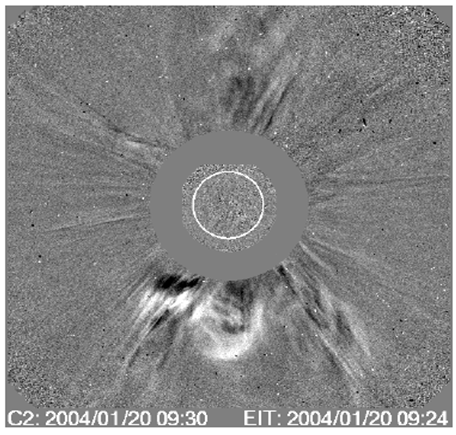 | Figure 5. Difference image taken at 09:00 UT (frame at 09:00 UT has its previous frame subtracted) of the CME event observed with the LASCO C2 coronagraph on January 20, 2004 |
|
2.2. Data Analysis
- For measuring the mean relative bandwidth, the fundamental of the multiple type II radio burst was divided into n equal time intervals (ti to tn). At each of these n time samples, the upper (fu) and lower frequency (fl) of the band split were measured. The mean relative bandwidth is given by
 | (3) |
 ) for the type II1 and type II2 radio bursts respectively are 0.28
) for the type II1 and type II2 radio bursts respectively are 0.28  0.03 and 0.20 0.04. These values are in close agreement with the relative bandwidth value of 0.3 for 25 type II bursts reported by Mann et al., (1995, 1996). Using the equations 1 and 2, Alfven Mach numbers were calculated and their values respectively are 1.44 and 1.27 for the type II1 and type II2 radio bursts, suggesting that these shocks are weak in nature and the shock speed is greater than the Alfven speed. The value of the Alfven Mach numbers estimated by us lies close to the range (1.5 - 2.5) of values reported by Nelson & Melrose (1985). The mean of the measured values of the upper (fu) and lower (fl) frequencies were plotted against time for both the type II1 and type II2 bursts. The scattered points are approximated by a straight line and least square fits were made and is shown in the figure 6. The drift rates were estimated from the slope the curves. The drift rates for the type II1 and type II2 bursts respectively are -0.11 and -0.08 MHz/s. These values agree with the rule that the drift rate of type II radio burst increases with their starting frequency (Mann et al., 1995; Subramanian & Ebenezer, 2006). The characteristics of the multiple type II radio burst like the relative bandwidths, drift rates, the derived values of density jumps and the Alfven mach numbers are given in the table 2.
0.03 and 0.20 0.04. These values are in close agreement with the relative bandwidth value of 0.3 for 25 type II bursts reported by Mann et al., (1995, 1996). Using the equations 1 and 2, Alfven Mach numbers were calculated and their values respectively are 1.44 and 1.27 for the type II1 and type II2 radio bursts, suggesting that these shocks are weak in nature and the shock speed is greater than the Alfven speed. The value of the Alfven Mach numbers estimated by us lies close to the range (1.5 - 2.5) of values reported by Nelson & Melrose (1985). The mean of the measured values of the upper (fu) and lower (fl) frequencies were plotted against time for both the type II1 and type II2 bursts. The scattered points are approximated by a straight line and least square fits were made and is shown in the figure 6. The drift rates were estimated from the slope the curves. The drift rates for the type II1 and type II2 bursts respectively are -0.11 and -0.08 MHz/s. These values agree with the rule that the drift rate of type II radio burst increases with their starting frequency (Mann et al., 1995; Subramanian & Ebenezer, 2006). The characteristics of the multiple type II radio burst like the relative bandwidths, drift rates, the derived values of density jumps and the Alfven mach numbers are given in the table 2.
|
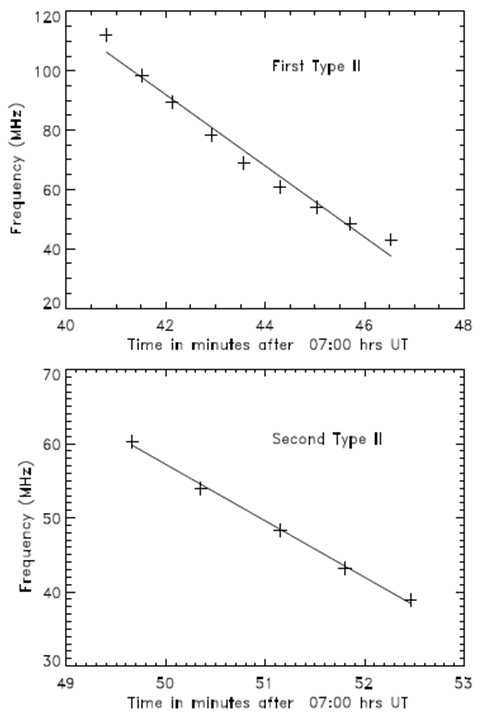 | Figure 6. Scatter plot of the mean frequency and time for the first and second type II bursts of January 20, 2004 |
 | (4) |
 (ρ is measured in solar radii) for the calculation of the speed of the type II radio bursts. We have used values of 1 to 5 for the density enhancement factor M in our calculations for the estimation of the shock speeds of type II radio bursts. Figure 7a shows the variation in the radial speed of type II1 and type II2 bursts for different density enhancement factors (DEF). From these values and the estimated Alfven mach No of 1.44 and 1.27 for the II1 and type II2 bursts, Alfven velocities are calculated and is shown in the figure 7b. Using the relation between the Alfven speed VA, the mean frequency of observation f and the magnetic field B (Dulk & Mclean, 1978) of the form
(ρ is measured in solar radii) for the calculation of the speed of the type II radio bursts. We have used values of 1 to 5 for the density enhancement factor M in our calculations for the estimation of the shock speeds of type II radio bursts. Figure 7a shows the variation in the radial speed of type II1 and type II2 bursts for different density enhancement factors (DEF). From these values and the estimated Alfven mach No of 1.44 and 1.27 for the II1 and type II2 bursts, Alfven velocities are calculated and is shown in the figure 7b. Using the relation between the Alfven speed VA, the mean frequency of observation f and the magnetic field B (Dulk & Mclean, 1978) of the form | (5) |
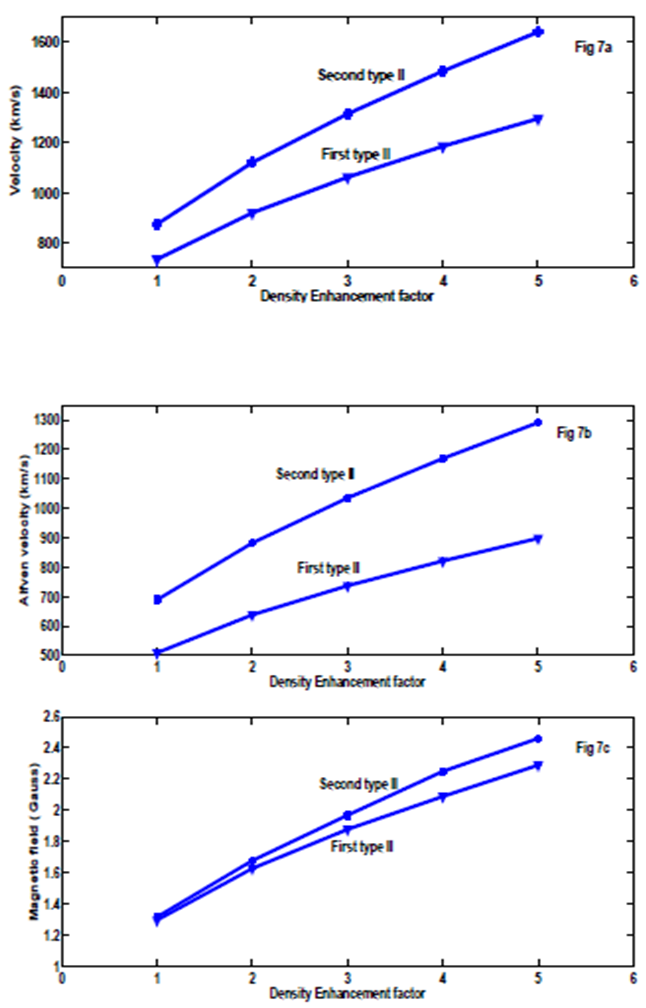 | Figure 7. Variation of the type II bursts speeds (fig3a), Alfven speeds (fig 7b) and magnetic fields (fig7c) with density enhancement factor M |
3. Discussions
- Multiple Type II radio burst observed on January 20, 2004 was analyzed. Associated events clearly show that there was only a single flare and a CME. The timing of CME onset at 1.5 R_ at 07::40:UT is close to the start timing of the type II1 burst. The closeness in the start timings of the flare and the multiple type II bursts suggests their close association. The estimated shock speed of the second type II radio burst was less than the first one for various densities we have used. The estimated Alfven Mach numbers for the first and second type II radio bursts respectively are 1.44 and 1.27 suggesting that these shocks are weak in nature. This is supported by the fact that these bursts have not been detected in the interplanetary medium by the IND/WAVES satellite. But only a type III burst has been observed by the WIND/WAVES satellite at the time of multiple type II bursts. One view is that multiple type II bursts are caused by a single flare (Gergely et al 1984) or a CME (Raymond et al 2000). According to this view that multiple type II bursts are caused by a single shock travelling through different coronal structures. Another view (Reiner et al 2001: Shanmugaraju et al 2005) is that two coronal shocks are generated from different sources; one burst is due to a flare and the other due to a CME. The scenario suggested by Cho et al. (2007) that multiple type II bursts are caused by a single shock travelling through different coronal structures like coronal streamers may be applicable in the present case since no multiple flares or CMEs are seen.In the present observations we found that there was only a single flare and a CME associates with the multiple type II burst. The drifting stripes of type II bursts are interpreted a signature of coronal shock waves, the frequency of radio emission can be converted into emission heights of heights by adopting a coronal density model. Since the second type II burst occurs at a lower frequency compared to the first type II burst, the emission height of the second type II burst is more than the first type II burst for the density multiplications factor 1 to 5 used here. Since no type III burst is seen between the multiple type II bursts in the present observations, we can be sure that there is no CME-streamer inter-action and the second burst is not generated by the interaction between the CME and the helmet streamer (Reiner et al 2003; Vourlidas et al (2003); Cho et al 2008 Mann et al., 1996).The derived Alfven speed and the hence the value of the magnetic field were found to increase with density. For density factors of 1 to 5 in the Newkirk’s density model, the derived values of the magnetic field were found to vary from 1.3 to 2.29 gauss for the II1 radio burst and from 1.32 to 2.46 gauss for the II2 radio burst. These values are in close agreement with the value of the magnetic field reported by Smerd et al., (1974), Dulk and McLean (1978), Kruger & Hildebrandt( 1993), and Vrsnak et al., (2001) at these heights. Radio heliographic observations by Robinson et al., (1985) have shown that often type II radio bursts do not propagate radially which means that shock velocity is underestimated. If θ is the angle between the radial density gradient and the direction of the source motion, the true velocity is given by Vtrue = Vobserved/cosθ. The same speed is obtained for 5 times the Newkirk’s density with angle θ= 47 degrees and 3 times Newkirk’s density with θ of zero degrees. Therefore, the assumption of radial motion of type II radio bursts will also contribute to errors in the estimation of the magnetic field. Since the derived magnetic field from the first and second type II bursts are nearly same in our case, the first type II burst may be generated in the nose of the CME and the second type II bursts at the flanks of the CME. Another possibility is the dimming of corona. Coronal dimming is a depletion of the brightness in the low corona and is associated with CME and is attributed to mass loss in the corona (Howards et al 2003). The mass loss and the lower density may be the reason for generation the second type II burst.
4. Conclusions
- We have used the relative bandwidth and drift rate properties of type II doublet radio bursts to derive magnetic field strength and the gradient of the magnetic field in the outer corona. The magnetic field strength was derived for different densities. The associated solar activities were described. The main results are1. The relative The relative bandwidth for the first and second type II bursts respectively are 0.28 and 0.20.2. The Alfven Mach numbers for the first and second bursts respectively are 1.64 and 1.44. 3. The mean frequency of the first type II burst is 73 MHz and the same for the second burst is 49 MHz.4. The derived magnetic field varies from 1.30 to 2.24gauss for the first burst and 1.32 to 2.46 gauss for the second burst for Newkirk’s density with density enhancement factors 1 to 5.
ACKNOWLEDGEMENTS
- We are immensely grateful to the scientific and technical staff of the Culgoora Radio Observatory, for their solar radio spectrograph and data on their website. The CME catalog we have used is generated and maintained by the Center for Solar Physics and Space weather, the Catholic university of America in cooperation with the Naval Research Laboratory and NASA. SOHO is a project of international cooperation between ESA and NASA.
 Abstract
Abstract Reference
Reference Full-Text PDF
Full-Text PDF Full-text HTML
Full-text HTML